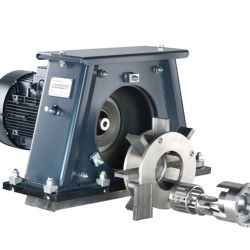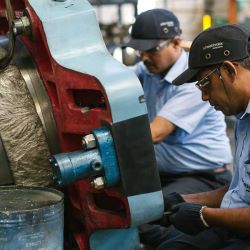Adding a new dimension to R&D with 3D printing
A glimpse into how we use 3D printing in LaGrange for our R&D.
For the past couple of years, we have used a MakerBot Replicator 2X Experimental 3D printer to help us design and develop prototype components. This helps to ensure we find a solution that is both fast and best for our customers’ manufacturing needs.
Testing complex designs
Wheelabrator is always looking at new ways to develop and test parts that we put into our machines. After all, there’s little point producing something that won’t deliver the optimum performance in real world conditions.
While digital testing is useful, some unforeseen errors can still occur in the physical model. Actually producing physical versions of the parts is also useful, as it helps confirm the findings of simulations. However, traditional machining methods can take significant amounts of time and is relatively expensive.
By producing scale models of components on the 3D printer, we are able to check the physical geometry of parts to ensure they fit together – especially if they have complex surfaces. We can then tweak and test again much more quickly than if we send a part to our machine shop. This can be for new parts to retrofit onto older machinery, or for completely new assemblies.
3D printing for R&D in practice
We used the 3D printer to produce the more complex geometry of the link mounting, to ensure that components could be retrofitted to existing tumble blast machines.
Using the 3D printer also helped our quality control department verify the complex component faces with their specifications. We were able to print the profile of the new fittings to help them do this instantly rather than using a coordinate measuring machine or a 3D scanner to verify the mounting face.
The 3D printer is also being used to evolve parts, including key machine components such as blast wheel components. The parts are printed out to test geometry and prove their design.
This approach accelerates the process, as the R&D team no longer needs to wait for the parts to be produced in a foundry or machine shop before testing them.
Breakdowns and teething problems
While the 3D printer is a great tool for testing complex designs, there have been challenges in using it. As we’re using an R&D printer (rather than a production-grade one), we occasionally have issues with it breaking down due to nozzle blockages or mechanical problems.
Initially, we also had the challenge of heat shrinkage when components alter their shape as they cool and solidify. We use a range of plastics – ABS, PLA and Taulman 910 nylon alloy – each of which have different properties as they liquefy for printing then cool once the component has been printed. However, we’ve since worked out how to make allowances to combat these shrinkage and material warp issues.
3D in the future
We plan to upgrade to a new model of 3D printer in the near future to continue benefiting from the capabilities it provides for R&D.
Currently, we only use 3D printing for R&D, partly because the printer we have only works with plastics. However, the technology could well be applied to producing machining fixtures or molds for metal parts or even the parts themselves. That’s an exciting opportunity we’re beginning to see and we’ll continue to use this evolving technology to create better solutions for our customers.


